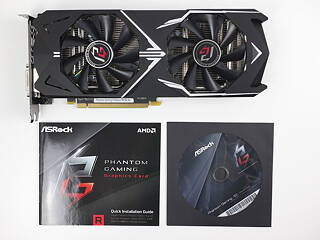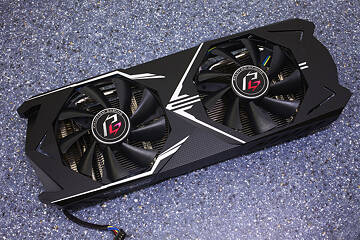 41
41
ASRock Radeon RX 580 Phantom Gaming X 8 GB Review
(41 Comments) »Introduction

We have with us ASRock's very first graphics card, the Radeon RX 580 Phantom Gaming X 8 GB. When ASRock started operations in the early-2000s, no PC enthusiast took it seriously. It focused on low-cost motherboards made on entry-level chipsets, but over the years, earned a lot of brand equity by targeting the largest segment of the market first. As the company became more independent from ASUSTek, it started directly competing across all market segments and earned respect from PC enthusiasts for coming up with some of the boldest and strangest motherboard designs. The company has since matured into a solid motherboard brand that has products in every price-band.
ASRock's expansion into other product segments beyond motherboards has been rather conservative compared to the likes of ASUS and MSI. The company is looking to change that with the biggest entry since motherboards - graphics cards. Several industry observers commented that ASRock's decision to sell graphics cards has less to do with PC gaming and more to do with the breakneck growth of GPU-accelerated blockchain compute, particularly crypto-currency mining. ASRock didn't take the route of some other graphics card manufacturers that made mining-specific graphics cards (which lack even display connectors, are extremely basic, and often with close to no product warranties). The company doesn't want to appear greedy to PC gamers, and hence, its graphics cards are full-fledged. Its first sub-brand for graphics cards is called Phantom Gaming, with an emphasis on "gaming."

AMD is the launch partner for ASRock's Phantom Gaming series, with the lineup being entirely based on the company's Radeon RX 500-series "Polaris" GPUs. The card we have with us is the top-dog Radeon RX 580 Phantom Gaming X 8 GB. This card combines a PCB that is custom-design, although laid out similar to AMD's reference-design PCB. There's also Micron-made 8 Gbps GDDR5 memory, and a cooling solution which many have commented looks identical to the ones found on some Colorful graphics cards (probably same OEM). This cooler is a proper aluminium fin-stack heatsink with copper heat pipes feeding heat to it.
The ASRock RX 580 Phantom Gaming X 8 GB is factory-overclocked to speeds of 1380 MHz out of the box, with two software-toggled presets either spooling it up to 1435 MHz (OC Mode) or bucking it down to 1324 MHz (Silent Mode). The card features 8 GB of GDDR5 memory across the RX 580's 256-bit wide memory interface. Pricing and availability is up in the air. You won't find it in Europe, and in the regions that you do, it's among the more affordable RX 580 cards. While official pricing isn't available yet, the card is expected to be one of the most affordable RX 580s on the market, so we picked a price of $290 for our comparisons (which is the price of the cheapest RX 580 on Newegg at this time).
| Price | Shader Units | ROPs | Core Clock | Boost Clock | Memory Clock | GPU | Transistors | Memory | |
|---|---|---|---|---|---|---|---|---|---|
| RX 470 | $400 | 2048 | 32 | 932 MHz | 1216 MHz | 1650 MHz | Ellesmere | 5700M | 4 GB, GDDR5, 256-bit |
| RX 570 | $250 | 2048 | 32 | 1168 MHz | 1244 MHz | 1750 MHz | Ellesmere | 5700M | 4 GB, GDDR5, 256-bit |
| GTX 970 | $300 | 1664 | 56 | 1051 MHz | 1178 MHz | 1750 MHz | GM204 | 5200M | 4 GB, GDDR5, 256-bit |
| RX 480 | $500 | 2304 | 32 | 1120 MHz | 1266 MHz | 2000 MHz | Ellesmere | 5700M | 8 GB, GDDR5, 256-bit |
| RX 580 | $290 | 2304 | 32 | 1257 MHz | 1340 MHz | 2000 MHz | Ellesmere | 5700M | 8 GB, GDDR5, 256-bit |
| ASRock RX 580 Gaming X | $290 | 2304 | 32 | 1257 MHz | 1380 MHz | 2000 MHz | Ellesmere | 5700M | 8 GB, GDDR5, 256-bit |
| GTX 1060 3 GB | $230 | 1152 | 48 | 1506 MHz | 1708 MHz | 2002 MHz | GP106 | 4400M | 3 GB, GDDR5, 192-bit |
| GTX 1060 | $300 | 1280 | 48 | 1506 MHz | 1708 MHz | 2002 MHz | GP106 | 4400M | 6 GB, GDDR5, 192-bit |
| GTX 980 Ti | $390 | 2816 | 96 | 1000 MHz | 1075 MHz | 1750 MHz | GM200 | 8000M | 6 GB, GDDR5, 384-bit |
| R9 Fury X | $380 | 4096 | 64 | 1050 MHz | N/A | 500 MHz | Fiji | 8900M | 4 GB, HBM, 4096-bit |
| GTX 1070 | $470 | 1920 | 64 | 1506 MHz | 1683 MHz | 2002 MHz | GP104 | 7200M | 8 GB, GDDR5, 256-bit |
| RX Vega 56 | $600 | 3584 | 64 | 1156 MHz | 1471 MHz | 800 MHz | Vega 10 | 12500M | 8 GB, HBM2, 2048-bit |
Packaging and Contents
You will receive:
- Graphics card
- Documentation + driver disc
The Card
ASRock's card comes with a fairly clean look and straight edges. The plastic shroud has some metal applications as highlights. A backplate is not available. Dimensions of the card are 26.5 cm x 11.0 cm. Note how the back of the shroud is just plastic without function; you could cut that off to fit the card in a smaller case, thus saving about 2.5 cm.
Installation requires two slots in your system.
Display connectivity options include a DVI port, one HDMI port, and three DisplayPorts.
The HDMI port is version 2.0b, and DisplayPort supports 1.3 HBR3/1.4 HDR ready, which enables support for 4K @ 120 Hz and 5K @ 60 Hz, or 8K @ 60 Hz with two cables. GPU-accelerated encoding is now supported for H.264 at up to 4K30, and HEVC is supported at up to 4K60. Accelerated decoding is supported for HEVC at up to 4K60 Main-10, VP9 is supported at up to 4K, and H.264 works at up to 4K120.
We shine the light from a self-leveling line laser onto the card, which shows no sagging.
Pictured above are the front and back, showing the disassembled board. High-res versions are also available (front, back).
A Closer Look
ASRock's card uses just three heatpipes—this is a much simpler (and cheaper) cooler than on the higher-end RX 580 models.
The board uses a single 8-pin power connector. This input configuration is specified for up to 225 watts of power draw.
AMD CrossFire has been running over the PCI-Express bus for a few generations now. The Polaris Series is no different.
Our Patreon Silver Supporters can read articles in single-page format.
Apr 2nd, 2025 18:19 EDT
change timezone
Latest GPU Drivers
New Forum Posts
- Questions about CPU thermal throttling mechanism (3)
- Post your Cinebench R23 multi-thread wattage on Raptor Lake K-CPUs (14)
- GPU-Z shows Resizable BAR supported for the RTX 2080 but it isnt? (4)
- New AM5 build [help] (8)
- The TPU UK Clubhouse (26034)
- Upgrading...Video editing; CPU, GPU, SSD/NVMe , Memory; how important is each one? (13)
- How reliable is Windows 11 Defender "Full" scan? (13)
- A Final Fantasy IX Reminiscence - My love letter and homage to one of the best stories ever told (79)
- Question about Intel Optane SSDs (61)
- Windows 11 General Discussion (5914)
Popular Reviews
- DDR5 CUDIMM Explained & Benched - The New Memory Standard
- Sapphire Radeon RX 9070 XT Pulse Review
- SilverStone Lucid 04 Review
- ASRock Phantom Gaming B850 Riptide Wi-Fi Review - Amazing Price/Performance
- Gigabyte GeForce RTX 5080 Gaming OC Review
- Palit GeForce RTX 5070 GamingPro OC Review
- Sapphire Radeon RX 9070 XT Nitro+ Review - Beating NVIDIA
- Samsung 9100 Pro 2 TB Review - The Best Gen 5 SSD
- be quiet! Pure Rock Pro 3 Black Review
- Assassin's Creed Shadows Performance Benchmark Review - 30 GPUs Compared
Controversial News Posts
- MSI Doesn't Plan Radeon RX 9000 Series GPUs, Skips AMD RDNA 4 Generation Entirely (146)
- Microsoft Introduces Copilot for Gaming (124)
- AMD Radeon RX 9070 XT Reportedly Outperforms RTX 5080 Through Undervolting (119)
- NVIDIA Reportedly Prepares GeForce RTX 5060 and RTX 5060 Ti Unveil Tomorrow (115)
- Over 200,000 Sold Radeon RX 9070 and RX 9070 XT GPUs? AMD Says No Number was Given (100)
- NVIDIA GeForce RTX 5050, RTX 5060, and RTX 5060 Ti Specifications Leak (96)
- Retailers Anticipate Increased Radeon RX 9070 Series Prices, After Initial Shipments of "MSRP" Models (90)
- China Develops Domestic EUV Tool, ASML Monopoly in Trouble (88)













